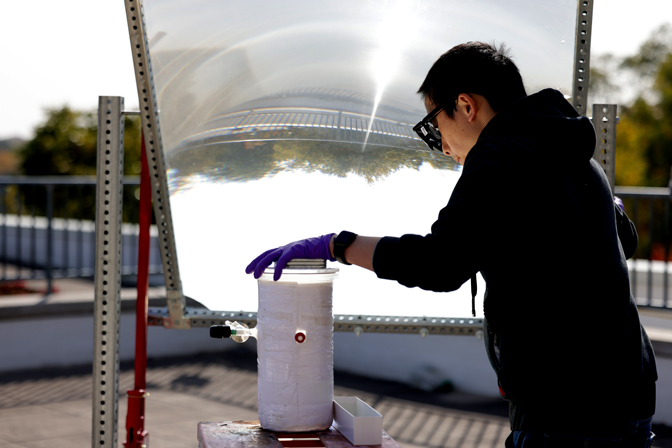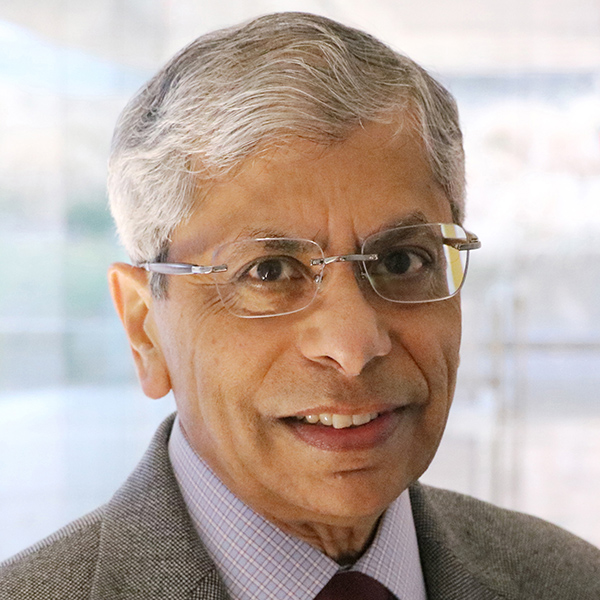Zetian Mi named Pallab K. Bhattacharya Collegiate Professor of Engineering

Zetian Mi has been named the Pallab K. Bhattacharya Collegiate Professor of Engineering in recognition of his outstanding contributions in the areas of research, innovation, education, and leadership.
“The Pallab K. Bhattacharya Collegiate Professorship in Engineering was established to honor Pallab K. Bhattacharya, who has made transformative impact on numerous researchers, including myself, as well as the fields of compound semiconductors, optoelectronics, and beyond,” said Mi.
Mi was advised by Bhattacharya as a doctoral student, and has carried on his advisor’s legacy of ceaseless innovation through hard work, vision, and collaboration.
Mi’s research focuses on the investigation of (ultra)wide bandgap semiconductors and their applications in electronic, photonic, clean energy, and quantum devices and systems. Specific areas of research include: fundamental properties of semiconductor heterostructures and nanostructures; III-nitride materials and devices, including ferroelectric nitrides; light emitting diodes (LEDs), lasers, and UV photonics; quantum photonics; and artificial photosynthesis, solar fuels and clean energy.

His worldwide leadership in multiple areas is reflected in two active Department of Defense Multidisciplinary University Research Initiatives (MURI) Programs, which he currently directs. One MURI is focused on the use of solar energy to generate clean chemicals and fuels through artificial photosynthesis. This project is called “Tunable III-Nitride Nanostructures for N≡N and C-H Bond Activation.”
The more recent MURI, “NanoTOP: Nanoscale and Transduction-Optimized Pristine Ferroelectrics,” is focused on ferroelectric semiconductors, which Mi says can potentially lead to next-generation microelectronic devices and circuits operating at incredibly high temperatures and speeds and with much reduced size and improved efficiency. Applications include space missions, electric vehicle engines, and ultrafast memory for AI and quantum computing.
Some of his research highlights include the demonstrations of the world’s most efficient artificial photosynthesis system capable of direct solar water splitting and hydrogen fuel production, the world’s first single crystalline ferroelectric nitride semiconductors with transformative potential for next-generation microelectronics and quantum photonics, and the world’s smallest and most efficient nanoscale light emitters for future display and virtual/mixed reality devices and systems.
His innovations have resulted in two startup companies: NS Nanotech and NX Fuels. NS Nanotech provides far-UVC light to deactivate airborne coronavirus and numerous other air- and surface pathogens. NX Fuels uses his artificial photosynthesis technology to transform sunlight, water, and carbon dioxide into clean hydrogen and high-energy-rich fuels.
Mi is a prominent leader and educator. He is Editor-in-Chief of Progress in Quantum Electronics, and co-editor of two newly published books that are part of Elsevier’s Semiconductors and Semimetals series. He served as General and Program Chair of the IEEE Photonics Conference and Compound Semiconductor Week Conference, Co-chair of the International Symposium on Semiconductor Light Emitting Diodes, and Vice President for Conferences for the IEEE Photonics Society. He is also a Distinguished Lecturer for the IEEE Nanotechnology Council and the IEEE Photonics Society.
He is a recipient of the Nick Holonyak, Jr. Award from Optica, the ISCS Quantum Devices Award, and the Science and Engineering Award from W. M. Keck Foundation. At the University of Michigan, he has received the David E. Liddle Research Excellence Award, the Rexford E. Hall Innovation Excellence Award, and the Wise-Najafi Prize for Engineering Excellence in the Miniature World. He is a fellow of four different professional societies: IEEE, American Physical Society, Optica, and SPIE, the international society for optics and photonics.
Zetian Mi received his B.Sc. in 1997 from the Beijing University, his M.Sc. in 2001 from the University of Iowa, and his Ph.D. in 2006 from the University of Michigan. He remained at Michigan to complete a post-doctoral research fellowship. In 2007, he joined McGill University as an assistant professor, and returned to Michigan as a professor in 2016.
Mi will present a professorship lecture to the community later this year.
About Pallab K. Bhattacharya

Pallab K. Bhattacharya joined the University of Michigan in 1984 as an associate professor. He was named James R. Mellor Professor of Engineering in 1999, and the Charles M. Vest Distinguished University Professor in 2004. During his 40 years at Michigan (he retired in 2024), he conducted groundbreaking research in optoelectronics, graduated 81 Ph.D. students, introduced four undergraduate and graduate courses, authored several books including the influential textbook Semiconductor Optoelectronic Devices, and is co-Editor-in-Chief and co-author of the six-volume Comprehensive Semiconductor Science and Technology.
Prof. Bhattacharya has been a renowned leader in the development and commercialization of quantum dot lasers and devices for a wide range of applications. He established extensive experimental facilities at Michigan in the area of optoelectronics, including those for semiconductor epitaxy with a technique known as molecular beam epitaxy (MBE).
His honors are extensive, and include the: Al Cho MBE Award, IEEE Jun-ichi Nishizawa Medal, IEEE David Sarnoff Award, Heinrich Welker Medal, TMS John Bardeen Award, IEEE Nanotechnology Pioneer Award, Nick Holonyak Jr. Award, IEEE (LEOS) Engineering Achievement Award, SPIE Technology Achievement Award, and an IEEE EDS Paul Rappaport Award. He has also served as an IEEE LEOS Distinguished Lecturer. He is a Fellow of IEEE, the American Physical Society, Optica, the Institute of Physics (UK), and the National Academy of Inventors. He was elected a member of the National Academy of Engineering “For contributions to quantum dot optoelectronic devices and integrated optoelectronics.”
 MENU
MENU 
